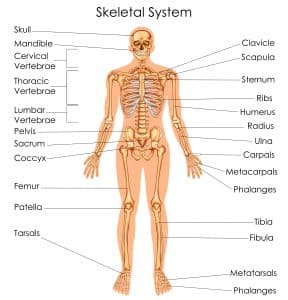Section 3: The Skeletal System

All movements in the human body are made possible by the interaction between muscles and the skeletal system. An adult skeleton is made up of 206 bones and has many essential functions. First, it gives shape and support to the body, providing the framework of stability the body needs. Secondly, bones protect internal organs. For example, your rib cage protects the heart and lungs. Thirdly, major muscles are attached to bones and work together to move. They also make blood cells that form in the red marrow at the center of bones. Finally, bones store calcium and phosphorus, which are important to many body processes.
You might think bones are completely solid, but they are made of both hard and soft materials. They are living tissue, continuously growing and developing as we do, giving them a unique structure. The thin, tough, fibrous membrane that covers the surface of a bone is called the periosteum. Beneath the periosteum is the compact bone, a hard, strong layer containing passageways where blood vessels and nerves travel. Spongy bone is found towards the ends of long bones with many spaces within it. It is strong and located at the ends of bones like the femur. Within the spongy bone tissue is marrow, the part of the bone that produces blood cells. There are two types of marrow. Red marrow produces all types of blood cells: red blood cells, white blood cells, and platelets. Yellow marrow stores fat as an energy reserve.
tough, fibrous membrane that covers the surface of a bone is called the periosteum. Beneath the periosteum is the compact bone, a hard, strong layer containing passageways where blood vessels and nerves travel. Spongy bone is found towards the ends of long bones with many spaces within it. It is strong and located at the ends of bones like the femur. Within the spongy bone tissue is marrow, the part of the bone that produces blood cells. There are two types of marrow. Red marrow produces all types of blood cells: red blood cells, white blood cells, and platelets. Yellow marrow stores fat as an energy reserve.
Another type of tissue essential to the skeletal system is a connective tissue called cartilage. Cartilage is a rubbery layer of tissue found at the ends of bones where they form joints. It is flexible and can support a significant amount of weight. Cartilage also acts as a cushion where bones meet.

The point at which two bones meet is called a joint. They have connective tissue that holds bones together and allows them to move. Joints are held in place by a tough band of tissue called ligaments that give them support and limit their movement. Joints are characterized by their structure and how they move. A pivot joint allows one bone to move around another. One example of a pivot joint is the top of your neck. It enables you to move your neck from side to side and shake your head. In a ball and socket joint, the rounded end of one bone fits into the cup-like structure of another. It gives the widest range of motion. The shoulder and hip are examples of ball and socket joints. Hinge joints, like those found in your elbow, allow back-and-forth movement. A gliding joint allows one part of a bone to slide over another, like those found in your wrist or ankle. An immovable joint allows little to no movement as the bones are fused together.
Review:
- Can you identify the different types of joints picture above?
- What are three functions of bones?
- Compare red marrow to yellow marrow.
